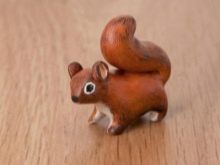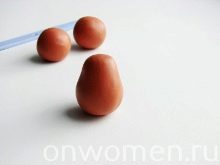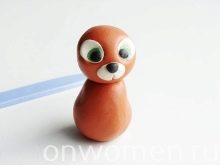How can you make a squirrel from plasticine?

It is important from childhood to engage in the comprehensive development of your child. For this, there are a lot of exciting activities that contribute to the formation and development of various skills and abilities. One of these is plasticine modeling, which is popular with both children and adults. Such a pastime will become the foundation for the formation of the child's artistic skills, the development of his creative thinking.
Most often, various representatives of the animal world with which the child is familiar are selected as images. For example, such a cute fluffy animal like a squirrel. Ask your baby if he knows about this animal, how the animal looks, where it lives, what it eats.
This is important, as it will help the child imagine how the future craft will look like and embody this image.



Classic version
You will be surprised by the variety of options for sculpting squirrels from plasticine. It can be the hero of your favorite cartoon (squirrel from the cartoon "Ice Age"), a character from children's books, and so on. In any case, everyone can blind such an animal.
Below will be described step by step how to make a plasticine squirrel for beginners. To do this, you need the following tools:
- a set of colored plasticine;
- a modeling board (a limited workspace teaches children order, and with the help of such a device, parents do not have to wash the table from the remains of plasticine);
- stacks.


Stages of work. Mash the block of orange plasticine well. Form three balls out of it: one large and two smaller ones. From the fact that you sculpt a little more elongated body of the future squirrel. It should be pear-shaped, flatten the top a little.We take one small ball and put it on a toothpick - this will be the squirrel's head. Then we attach it to the body from above.



On the head we make two indentations for the eyes. We insert two small balls of white plasticine into the made recesses and press them down so that they are distributed around the entire perimeter of the pits. First we stick green balls on the inside of the peephole, and black balls on top.
We make the muzzle from an oval piece of white plasticine, and the nose from a small black ball. We stick the muzzle and nose on the head and adjust their shape using a stack.



From a small piece of orange we fashion two small flat ears and attach them to the top of the head. Draw the brushes at the tips in a stack. Form a small ball from a piece of white tone, then press on it to make a flat circle, which you attach to the figurine's belly - this will be its belly.



We make the front legs in a teardrop shape and fasten them towards the tummy. For the back ones, consisting of two parts, we form two small balls and two larger ones. We stick them to the body. Draw the fingers in a stack. From another piece of orange plasticine we form an S-shaped tail of the animal and attach it to the back. The beautiful squirrel is ready.
Such a product is an excellent craft option for children in kindergarten or school.


How to sculpt with cones?
Very often in schools or kindergartens, giving the task to make a fake, they are asked to use various natural materials, such as cones (pine, spruce), chestnuts, and acorns. It is much more interesting to sculpt such products than just from plasticine. We suggest that you familiarize yourself with a master class on modeling squirrels from plasticine using cones, in which all actions are described step by step.
To make a sculpture of a squirrel from cones and plasticine, you will need the following tools:
- three cones of equal diameter;
- plasticine;
- modeling board;
- stacks.


Stages of work.
- We start with the head of our squirrel. We will make it from the smallest bump. From orange-colored plasticine, we form a slightly elongated muzzle and attach it to the base of the cone. Next, we form two small white balls and sculpt them on the muzzle - these will be the eyes of the animal. We stick two small black dots in the center of the eyes.
- For the nose, we take a small ball of black plasticine and attach it to the tip of the muzzle.
- For the ears, take orange plasticine and sculpt two elongated volumetric ears from it and fix them on the top of the head.
- We take a cone of the largest size - it will serve as the body of the future animal. From orange plasticine we form a small ball, which we flatten and stick to the base of the cone. On top we attach the finished head of our squirrel.
- Next, he proceeds to the tail, we make it from a medium-sized cone. Form a ball from orange plasticine and crush it. On the body, where the tail will be located, we sculpt an orange cake, and to it we stick the middle bump, which will serve as the tail.
- The last stage is the formation of the animal's legs. We also make them from orange plasticine and attach them to the body of the figurine.
The forest beauty is ready. Even a first grader can do such a craft with his own hands. It is done very easily and looks beautiful.


Modeling with acorns
Another interesting option for sculpting squirrels from plasticine is the use of acorns in the craft.
To do this, you will need:
- acorns with a cap;
- a set of plasticine;
- black felt-tip pen;
- a piece of fluffy spruce branch and tough grass;
- stacks.



Stages of work.
- We take two acorns of different sizes. Remove the hat from the middle one - this will be the head of the future animal. Place the large acorn so that the cap is at the bottom. We attach the head on top with a piece of orange plasticine.
- From a piece of orange-colored plasticine, we form the elongated ears of the squirrel, as well as the lower and upper legs.
- Next, we attach the front legs to the sides of the body, and we sculpt the back legs onto the cap from the bottom of the body.
- Form a small black ball (nose) and two white balls (eyes). We sculpt them on the muzzle of the squirrel. Make black dots in the center of the eyes with a black felt-tip pen.
- The tail of our animal (a spruce twig or any other dry grass) is attached to a piece of orange plasticine to the back of the body.
- You can stick a small acorn to the paws of the animal, and we make brushes on the ears with the help of small blades of grass.
The craft is ready. It looks very original and is easy to do.


To learn how to mold a squirrel from the cartoon "Masha and the Bear" from plasticine, see the next video.








